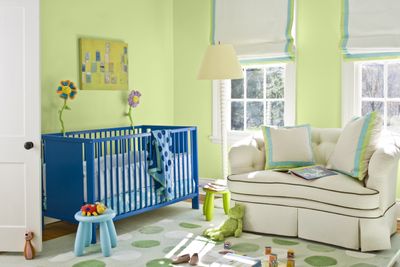An eco-friendly shade of green
What nontoxic paints lack in scent, they make up for in vibrant colors

Spring often brings the urge to clean, perhaps to liven up a room with a fresh coat of paint. Now that can be done with eco-friendly paints that don’t give off noxious odors. The nontoxic arm of the household paint world is booming, and many companies have entered the market.
AFM’s Safecoat brand is the granddaddy of the nontoxic paint business, having been in the market for 25 years. Boutique brands, including Mythic and YOLO Colorhouse, have cropped up in recent years, and industry giants tout their own nontoxic, latex brands.
Sherwin Williams has its Harmony line, while Home Depot sells Freshaire Choice. Benjamin Moore already sells its low-toxic Aura but is rolling out a new, zero-VOC interior paint called Natura that it says will be available in all of its nearly 3,000 colors.
“Everyone is trying to paint a green face on themselves,” says David Johnston, 58, of Boulder, Colo., a building consultant who wrote “Green from the Ground Up: Sustainable, Healthy and Energy-Efficient Home Construction” (Taunton, 2008).
“That ‘new house smell,’ as much as we’ve come to love it, is really a flag that there’s something in the air that we don’t want our kids to breathe,” he says.
VOC refers to volatile organic compounds, those chemical additives that make regular paint work its magic: They help it roll on smoothly, dry fast and prevent mildew. Some of these chemicals are natural (but still toxic), such as formaldehyde, which is added to curtail chipping.
Not all paints have the same types and frequency of VOCs, which can cause smog and deplete the ozone. Some of the compounds have been linked to cancer, and the paint smell that lingers for days or weeks after painting is the “off gassing” of these chemicals.
The Environmental Protection Agency reports that exposure to paints high in VOCs can cause headaches, dizziness and vision problems, among other symptoms, depending on which chemicals are in the paint, how long the exposure is and a person’s age (kids are more vulnerable).
These paints are regulated, to some degree, and cannot include more than 250 grams per liter of VOCs.
Nontoxic latex paint is not regulated. The most eco-friendly paints have zero VOCs, but some paints are low-VOC, with 50 grams per liter.
So how does a consumer know if a paint brand really is nontoxic?
Industry insiders suggest a simple sniff test: If the paint smells noxious, it has VOCs, perhaps a lot of them. If it’s odorless, or smells like fresh milk, then it’s likely a nontoxic paint.
“If something smells pungent, or if it burns your nose or your eyes, you know that’s probably not something you want to paint with,” says Carl Minchew, director of color technology at Benjamin Moore in Montvale, N.J.
However, because some toxic chemicals are odorless, Johnston advises that consumers read labels and look for certification, such as from Greenguard or Green Seal, that a brand is eco-friendly.
Not all paints that advertise as eco-friendly actually are, warn industry insiders. Colorants added to the nontoxic base paint at the retail store can shoot up the levels of VOC, says Minchew, with darker colors, such as reds, carrying the highest levels.
Benjamin Moore uses a new, waterborne colorant system that adds no toxins to Natura, he says.
AFM is rolling out a new brand called Safecoat Naturals that will use zero-VOC colorants, said AFM vice president Jay Watts in San Diego, Calif.
Nontoxic latex paints are similar in price to high-end latex ones. For example, Benjamin Moore’s Natura line will retail for about $50 a gallon.
They dry faster than regular latex paints because the water in zero-VOC paints evaporates faster than the other paints’ petroleum products.
“You can paint in the room in the morning and eat in there in the evening,” says Minchew. “That’s something you couldn’t do with a traditional, latex paint.”
Alex Rossi, 34, a Denver-area house painter, uses only nontoxic paints, and says they are as simple to use and durable as regular latex, or oil, paints.
Years ago, the zero-VOC paints didn’t work as well as regular latex paints, Rossi says; they didn’t cover a surface as easily or thoroughly. Today, he finds that’s not the case.
“What the green paint companies have done is they’ve found ways to make their paint more scrubbable and more user-friendly to compete with the old, traditional coatings,” Rossi says. “With two coats of the two products (latex and zero-VOC latex paint) side by side, I see no difference.”
Some of his customers, such as Laurie Tamm, 52, of Boulder, Colo., are chemically sensitive.
Tamm says that immediate exposure to toxic chemicals such as VOCs in paint (or other household products, such as carpets and cabinetry) can give her headaches, anxiety, depression and even paranoia. She thinks of herself and other chemically sensitive people as the proverbial canaries in the coal mine.
“I’ve been going through this for 20 years,” says Tamm, adding that she cannot enter newly built buildings because of fumes. “If anyone is going to start the trend (of using nontoxic paint), it has to start with people like me.”